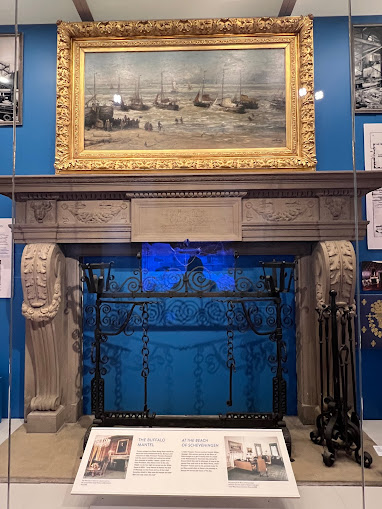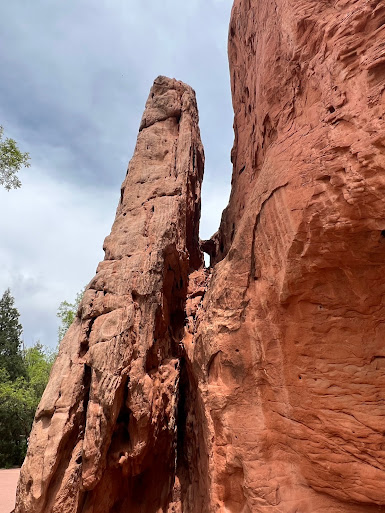Diamond Campground and RV Park - Woodland Park, CO
Garden of the Gods is a 1,341 acre public
park located in Colorado Springs. 862 acres of the
park was designated a National Natural Landmark in 1971. Acreage has been added over the years as it was acquired.
The area now known as Garden of the
Gods was first called Red Rock Corral by the Europeans. In
August 1859, two surveyors who helped to set up Colorado City, explored
the site. One of the surveyors, Melancthon S. Beach, suggested it would be a
"capital place for a beer garden". His companion, the young
Rufus Cable, was so awestruck by the impressive rock formations, he exclaimed, "Beer
Garden! Why, it is a fit place for the Gods to assemble. We will call it the
Garden of the Gods" as reported by the April 5, 1893 issue of the Colorado Transcript.
You can see Pikes Peak (the snow capped mountain in the far distance) from the Garden of the Gods.
Karma was resting (or maybe posing?) on the rocks. He typically finds a shady spot to rest, but we were above the tree line, so there were not any trees this high up.
Lisa and Karma were mountaineering while at the Garden of the Gods.
This is a perfect example of Karma finding a shady spot to rest. He is truly not a fan of the heat but he does keep us entertained. He is a pretty good hiking partner.
Overlooking Colorado Springs, we were able to see for many miles.
Most of the park has red sandstone, yet there was this one area of white stone. It was a stark contrast from the sandstone found everywhere else in the park. The picture does not show the surrounding stone, but it is all red sandstone around this section of white rock.
This is a massive bronze plate mounted into the side of the cliff honoring Charles Perkins for his donation of 480 acres to the city to establish a free, public park.
She is getting braver. She will be free climbing soon (just as soon as the proverbial Hades freezes over). She struggles a bit with these tiny ledges and nothing to break her fall. Grace has never been her strength and the fear of falling typically keeps her as far away from the ledge as she can get.
We saw a cat at the top of this rock formation ready to pounce. We both spot many images in the rocks while we hike, but we seldom see the same things.
These were two separate views of the Balanced Rock. Every park seems to have at least one similar rock precariously perched and aptly named Balance Rock.
_________________________________
The Florissant
Formation is a sedimentary geologic formation outcropping around Florissant, Teller
County, Colorado. The formation is noted for the abundant and exceptionally
preserved insect and plant fossils that are found in the mudstones and shales.
Based on argon radiometric dating, the formation is Eocene (approximately
34 million years old) in age and has been interpreted as a lake environment.
The fossils have been preserved because of the interaction of the volcanic ash
from the nearby Thirty nine Mile volcanic field with diatoms in the
lake, causing a diatom bloom. As the diatoms fell to the bottom of the lake,
any plants or animals that had recently died were preserved by the diatom falls.
Fine layers of clays and muds interspersed with layers of ash form "paper
shales" holding beautifully preserved fossils. The Florissant
Fossil Beds National Monument is a national monument established
to preserve and study the geology and history of the area.
The
name Florissant comes from the French word for flowering. In
the late 19th century, tourists and excavators came to this location to observe
the wildlife and collect samples for collections and to study. The Petrified
Forest, which is one of the main attractions at the monument today, lost much
of its mass due to collectors removing large amounts of petrified wood from
the site. The removal of the Petrified wood includes the stump Walt
Disney removed and has on display at Disney World.
In 1969, the Florissant Fossil Bed National Monument was
established after a long legal battle between local land owners and the federal
government. Today, the park receives approximately 60,000 visitors a year, and
is the site of ongoing paleontological investigations.

Hornbeck Homestead is the last of the remaining buildings from the 1800's community still in the Park.
This appears to be regular wood that had been torn apart, but it is actually petrified wood. The petrified wood here is completely different from what we saw in the Petrified Forest in Arizona. Structures have been erected over several of the larger remaining pieces of petrified wood to protect and keep the weather off them.
We had wrongly assumed that the Petrified Forest in Arizona was the only place where petrified wood existed. We have seen it in both National Parks/Monuments and on many of our hikes throughout Utah and Colorado. It makes us very thankful that our ancestors realized these areas needed to be protected. Obviously, many of the areas could have been protected much earlier than they were. The forward thinking of many people have ensured this and many other areas will be protected for our children and theirs in the years to come.



































.jpg)
.jpg)



























































